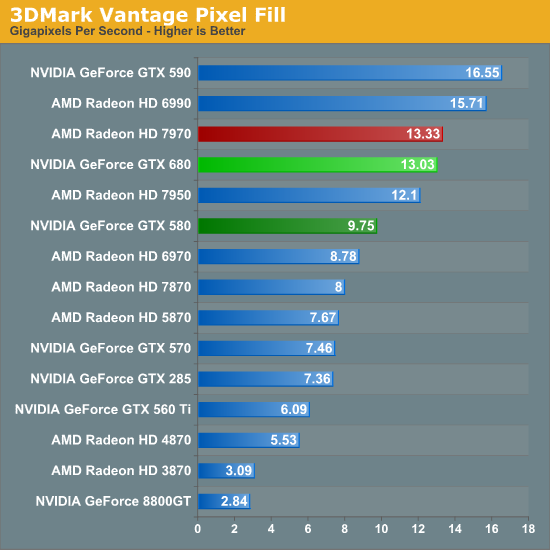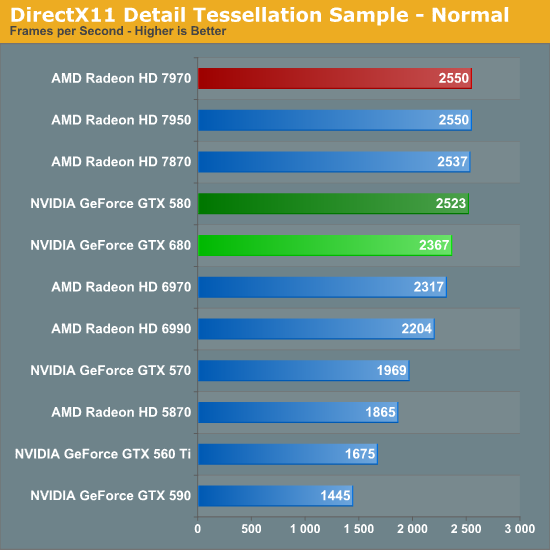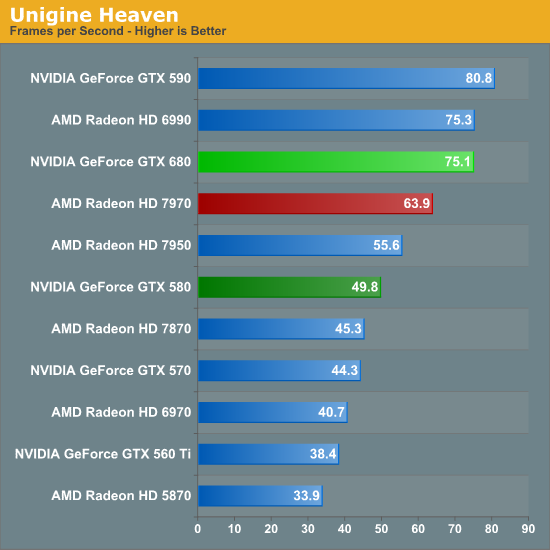NVIDIA GeForce GTX 680 Review: Retaking The Performance Crown
by Ryan Smith on March 22, 2012 9:00 AM ESTTheoreticals
As with any new architecture, we want to take a few moments to look at theoretical performance. These numbers shouldn’t be taken too seriously for cross-vendor comparison, but these numbers often tell us more about interesting architectural improvements that occur from one generation to the next.

Our first theoretical test is perhaps the most perplexing: 3DMark Vantage’s pixel fill test. Typically this test is memory bandwidth bound as the nature of the test has the ROPs pushing as many pixels as possible with as little overhead as possible, which in turn shifts the bottleneck to a mix of ROP performance and the memory bandwidth needed to feed those ROPs.
Compared to the GTX 580, the GTX 680 has almost exactly the same amount of memory bandwidth (192GB/sec) and only 86% of the theoretical ROP performance (37Gpix vs. 32Gpix). In short, it shouldn’t outperform the GTX 580 here, and yet it outperforms the 580 by 33%.
Why does it do this? That’s the hard thing to answer. As we mentioned in our look at GK104’s architecture, NVIDIA did make some minor incremental improvements to their ROPs coming from GF114, such as slightly improved compression and improved polygon merging. One of those may very well be the contributing factor, particularly the compression improvements since this is a typically memory bandwidth bottlenecked test. Alternatively, it’s interesting to note that the difference between the two video cards is almost identical to the difference in the core clock. GTX 560 Ti’s results tend to blow a hole in this theory, but it bears consideration.
In any case, it’s an interesting turn of events and hopefully one that isn’t simply an edge case. As we’ve seen in our benchmarks GTX 680 has strong performance – even if its lead compared to the 7970 diminishes with resolution – but compared to the GTX 580 in particular it needs strong ROP performance across all games in order to deliver good performance at high resolutions and anti-aliasing.

Our second theoretical test is 3DMark Vantage’s texture fill test, which to no surprise has the GTX 680 handily clobbering all prior NVIDIA cards. NVIDIA’s inclusion of 128 texture units on GK104 versus 64 on their previous generation GPUs gives the GTX 680 far better texturing performance. The 30%+ core clock difference only serves to further widen the gap.


Our third theoretical test is the set of settings we use with Microsoft’s Detail Tessellation sample program out of the DX11 SDK. Overall while NVIDIA didn’t make any significant changes to their tessellation hardware (peak triangle rate is still 4/cycle), they have been working on further improving performance at absurdly high tessellation factors. You can see some of this in action at the max factor setting, but even then we’re running into a general performance wall since the Detail Tessellation program can’t go to the absolute highest tessellation factors NVIDIA’s hardware supports.

Our final theoretical test is Unigine Heaven 2.5, a benchmark that straddles the line between a synthetic benchmark and a real-world benchmark as the engine is licensed but no notable DX11 games have been produced using it yet. In any case the Heaven benchmark is notable for its heavy use of tessellation, which means it’s largely a proxy test for tessellation performance. Here we can see the GTX 680 shoot well ahead of the GTX 580 – by more than we saw in the DX11 Detail Tessellation sample – but at the same time there’s a lot more going on in Heaven than just tessellation.
Honestly at this point in time I’m not sure just how much more tessellation performance is going to matter. Until DX11 is the baseline API for games, tessellation is still an add-on feature, which means it’s being used to add fine detail to specific models rather than being used on everything in a game world. This demands good tessellation at high factors but at the same time it’s subject to diminishing returns on the improvement to image quality as triangles reach single pixel sizes and smaller. To that end I’m still waiting to see the day where we see tessellation scale similarly to textures – that is by using full MIP chaining of displacement maps – at which point we can evaluate tessellation performance similar to texture performance when it comes to both measuring the performance hit and evaluating the difference in image quality.










404 Comments
View All Comments
SlyNine - Thursday, March 22, 2012 - link
Wait the boost speed is 1110 vs 1005 right? So 10% faster in shader performance, which will = about 5% in benchmarking performance in the best case.Nothing to see here move along.
Janooo - Thursday, March 22, 2012 - link
Well, 7970@1.1GHz beats plain 680.SlyNine - Thursday, March 22, 2012 - link
Who cares, I wan't to know what the card comes shipped as. Thats what matters, anything extra you get out of that is exactly that, extra. What comes out of the box, thats what they are promising.BoFox - Friday, March 23, 2012 - link
Wait, you mean that HD 7970 needs to be overclocked by more than 20% in order to beat plain 680?How about overclocking that 680 by 15% like most review sites show is possible?
Then the 7970 would need to be overclocked by an impossible 35% in order to beat a 680 overclocked by 15%.
That was a nice try, Janooo!
Janooo - Friday, March 23, 2012 - link
It seems you missed the point.Whatever speed 680 has 7970 can match it. These cards are equal in this regard.
When they have the same clock speed then it looks like 7970 is faster.
Look for AMD to release a faster card soon.
CeriseCogburn - Friday, March 23, 2012 - link
We will have to subtract some mhz from the 7970 for having a larger core with more die space to make it fair, so transistor for transistor Kepler wins big.CeriseCogburn - Friday, March 23, 2012 - link
Plus were going to have to subtract more from The Heatie because it cheats on ram size too.Thanks Janooo you have great ideas.
BoFox - Monday, March 26, 2012 - link
Ok, if I go by your analogy and say that overclocking GTX 580 to the same speed as HD 6970 (880 MHz) makes both cards "equal in this regard."When they have the same clock speed then it looks like GTX 580 is faster.
Look for Nvidia to release a faster card soon ultilizing that 8-pin PCI-E connector on the PCB (which it did not need in order to beat HD 7970 overclocked or not).
CeriseCogburn - Tuesday, March 27, 2012 - link
680 has made 1,900mhz and makes well over 1,280 ouit of box reference...SlyNine - Thursday, March 22, 2012 - link
Why, thats how it is setup stock. That is how EVERY SINGLE CARD will come.